Hand-pulled noodles are a northern Chinese specialty. (Rice is eaten mainly in the south, while flour-based products, like noodles, dumplings, and pancakes, are eaten in the north.) Fancy hotel restaurants often feature a chef making these noodles right in the dining room in front of the patrons, with many flourishes and great drama. At such venues they are advertised as “dragon whiskers” because they are pulled into fine threads – and because it sounds so exotic they can charge a lot more for a bowlful! But we know and love them simply as la mian, which literally means “pulled noodles.” We don’t bother going to fancy places to eat them because we can find the authentic article about 100 yards from our front door.
We enjoy la mian most often at Malan, a popular fast-food chain. This a branch right across the street from our apartment on Ritan Beilu. Miranda's favorite Beijing restaurant, it’s open 24/7 and usually packed.
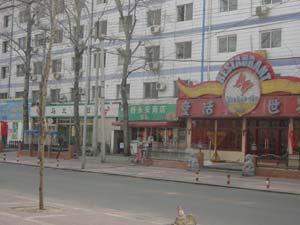 |
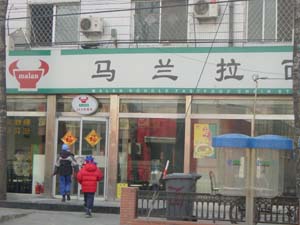 |
The signature dish is beef noodles in broth – note the storefront logo – and although many other types of noodles are on the menu, we’re pretty faithful to the niu rou mian (literally: "beef noodles").
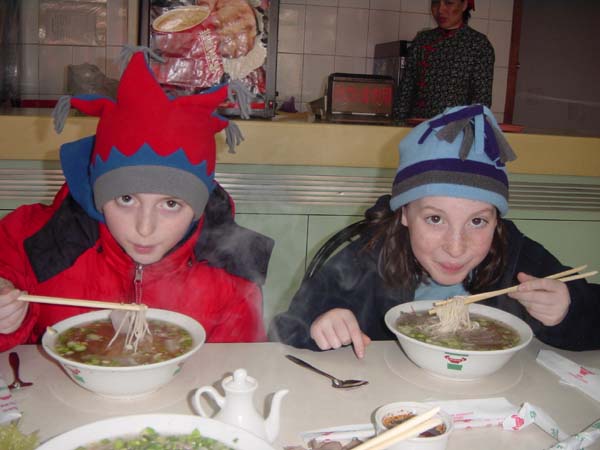
Once an order is called in, the noodle guy goes to work, yanking a wad of dough off a big log, rolling it into a ball, giving it a few kneads and then, in about 10 seconds, pulling it a dozen or so times between his hands to form a skein of thin noodles to be flung into a big pot of boiling water.
Because they’re fresh, the noodles cook in just a minute or two. They’re fished out and plopped into a bowl filled with simmered stock, and topped with thin slices of radish, chopped scallions, and beef. (I often splurge and order an extra side of the sliced beef for another 2 yuan.)
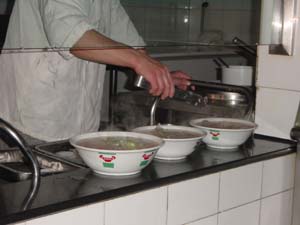 |
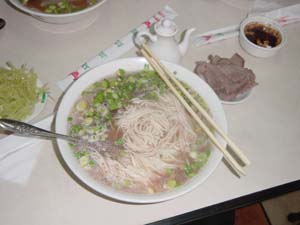 |
One “small” bowl, which is just the right size for a kid, costs 4 yuan. That’s just under 50 cents. A “big” bowl, filling enough for a hungry grown-up, costs 5 yuan, or about 65 cents. We slurp them down with bottled water, but that costs 4 yuan – just as much as the noodles!
|
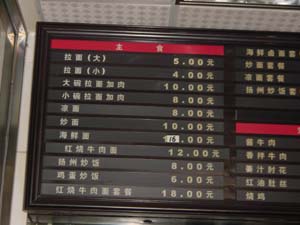 |
So when we remember to do so, we bring water from home. Most Chinese people don’t drink anything with their noodles; the broth itself is the drink. When our housekeeper, Long Fang, makes us soup for dinner, she always remarks how strange it is that we drink water along with it! Just in front of Miranda’s water bottle, you can see a small bowl with a white spoon resting in it. That’s la jiao– hot pepper oil. We stay far, far away from that stuff, but we often see people take huge, heaping spoonfuls of la jiao and plopping it into their noodles. Yikes! |
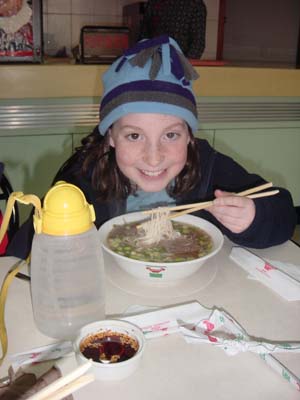 |
We Pull Our Own Noodles at the Chinese Culture Club
Almost every week, the Chinese Culture Club, founded and run by a wonderful, knowledgeable Beijing native named Feng Cheng, offers a tour to an interesting cultural site in Beijing, and almost that often, we go along. Even better, CCC also has hands-on workshops. We’ve learned how to perform a tea ceremony, do a Yunnanese peacock dance, and tried our hands at calligraphy. When CCC offered a hand-pulled noodle-making workshop one Sunday afternoon in November 2004, we joined four other folks to learn to la those mian.
Feng Cheng had invited an expert noodle chef to teach us the technique. The dough is simplicity itself; a combination of regular flour and water, plus a bit of salt. The chef brought a bag of prepared dough, so we could skip this step. He noted that the dough is more workable if it’s been made at least a few hours in advance.
First step, kneading. The chef demonstrated a technique using the knuckles of crossed hands to push the dough out in two directions at once.
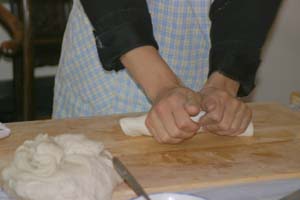 |
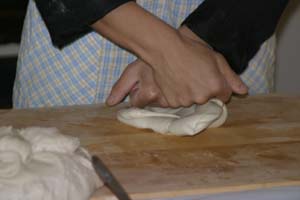 |
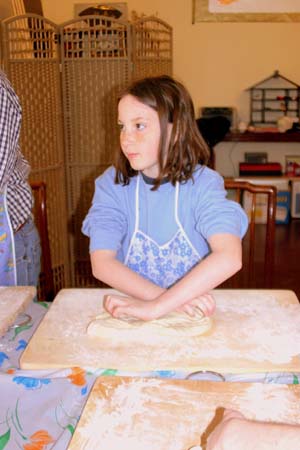 |
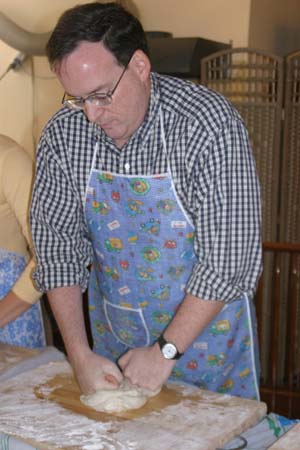 |
| After kneading awhile, our dough got nice and soft and stretchy. | 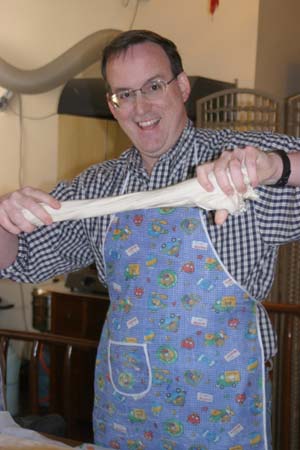 |
Then a surprise – a “secret sauce”! The chef pulled out an unmarked baggie full of fine, gray powder, spooned some into a bowl, and added water. When we sniffed the resulting brew, we were astonished – “it smells just like noodles!” said Tom. It’s a common fragrance, pervasive in Taiwan, Hong Kong and the mainland, and Tom and I had smelled it in so many of these places over so many years that we hadn’t realized it’s a distinct odor derived from this special powder. It has a strong whiff of sulfur, of all things, as well as a sort of musty, salty note. Impossible to describe, but it definitely announces “noodles!” to your nose. It’s just one of those smells that’s firmly rooted in China, like soy sauce, or coal smoke, or…well, I’ll leave it at that.
We asked repeatedly what was in the powder, where one buys it, its origins, and so forth. The chef was extremely evasive, not really answering our questions. He did say that the broth, in addition to giving the noodles their characteristic taste, also helped tenderize the dough, which we found to be true after we added it.
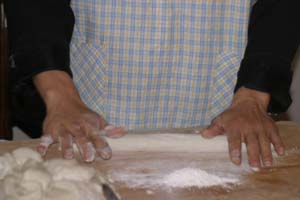 |
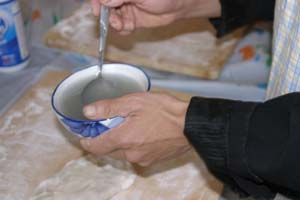 |
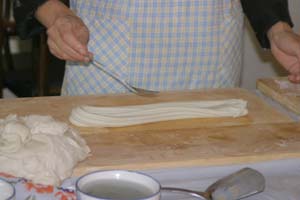 |
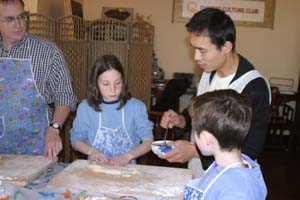 |
We thought that maybe it was one of those secrets that foreigners aren’t
allowed to know…but even Feng Cheng couldn’t get a straight
answer out of him!
The dough was now the right consistency, and we were all ready to pull!
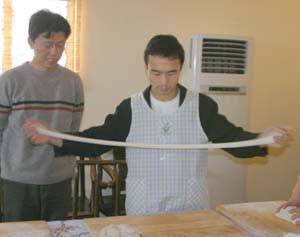 |
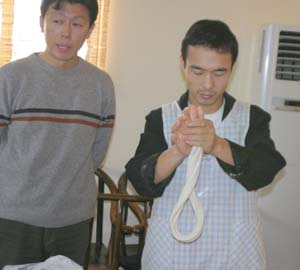 |
Miranda was turned off by the sulfurous smell of the secret sauce, and declined to add it to her dough. As a result, her dough stayed a little too stiff for pulling, but she didn’t mind – instead, she turned it into homemade play dough!
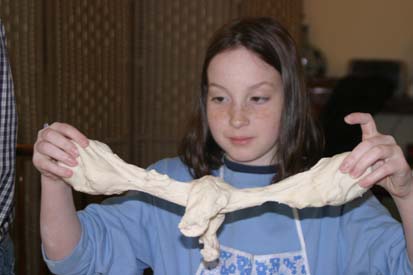 |
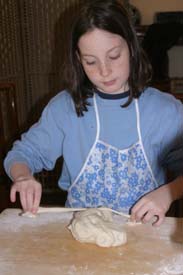 |
| Once we started to pull, the sulfur smell got even stronger, and she beat a retreat to a far corner, pulling a book out of the CCC library and rejoining us only when the noodles were safely in the pot. |  |
The chef was a man of very few words, and Feng Cheng supplied commentary and explanations as the chef demonstrated in slow motion. The key is the use of the thumb and first two fingers, shaped into a claw, to hold the dough. Another fine point is to briefly rest the dough in a triangle shape on the board between pulls.
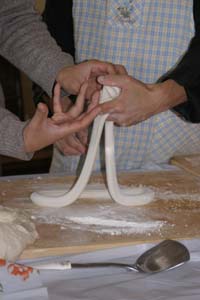 |
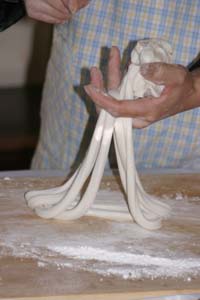 |
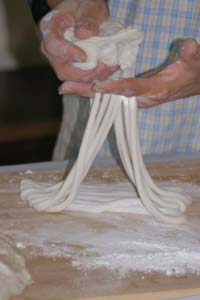 |
The chef pulled the dough between his hands nearly the length of his outstretched arms to produce fine, even strands.
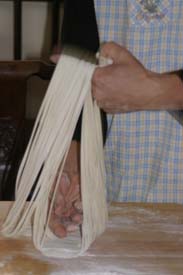 |
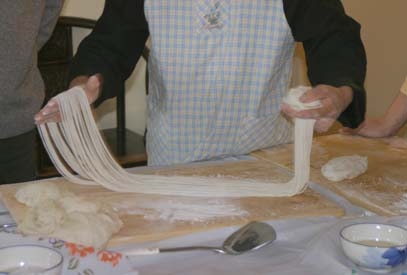 |
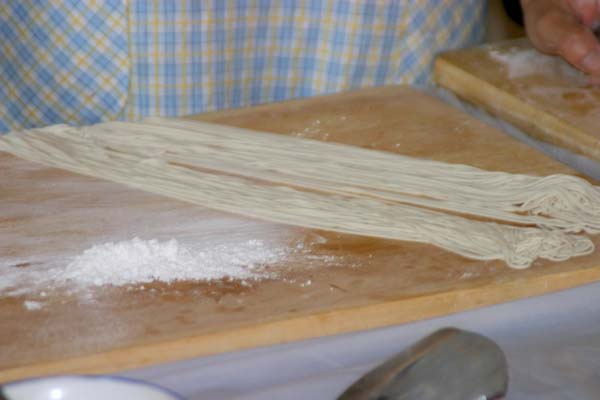
Tom’s first attempt ran into a sticky problem. The chef showed him a trick or two, then came around the table to help position Tom’s hands using the crucial claw-and-triangle method.
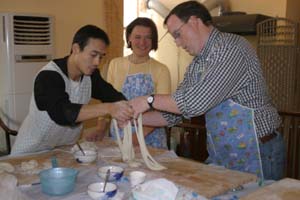 |
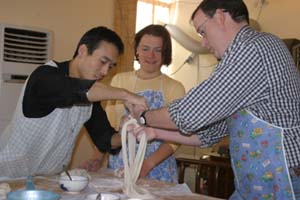 |
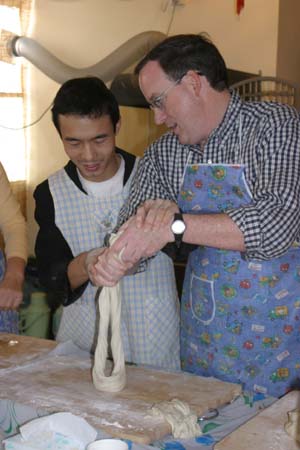 |
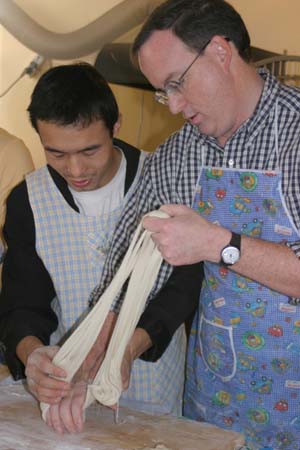 |
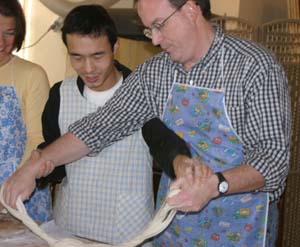 |
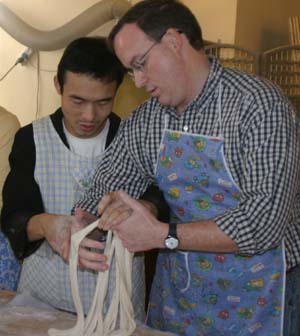 |
A quick re-knead, and then…success! A perfect batch of silky, whisker-thin noodles!
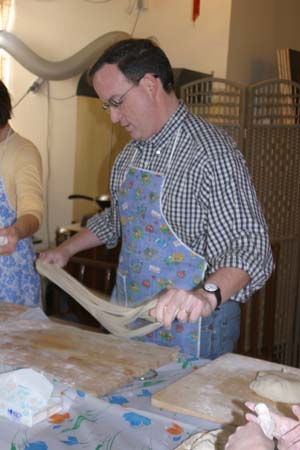 |
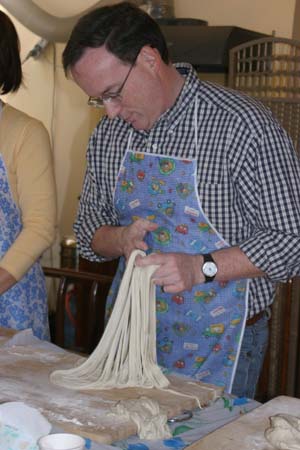 |
Sami, who loves activity, especially cooking, that lets her get her hands into things, got right down to it. After a single false start and a couple of pointers from the chef, she was pulling away! |
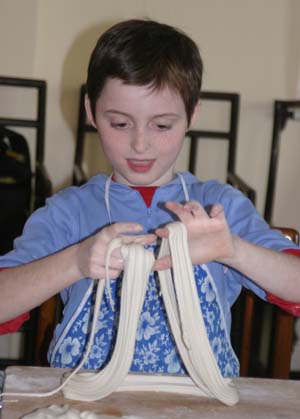 |
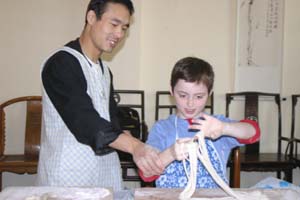 |
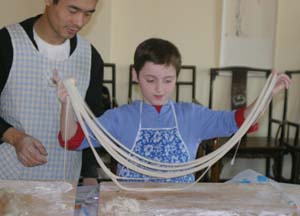 |
 |
 |
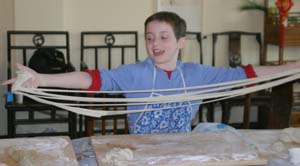 |
 |
She made batch after batch, re-kneading the same piece of dough until
it – and she – was too tired to make any more. (Though I spent
most of my time behind the camera, I note with modesty that I also succeeded
in pulling a set of very nice noodles, too.)
| Time to eat! Most of our noodles were pretty passable in terms of length and thinness, but we had pulled them so many times that their consistency – not to mention cleanliness – was a little uncertain by that point. So while we took a three-minute breather, the chef whipped out eight perfect batches of noodles, swung them into a pot of bubbling water, and Feng Cheng served them up. | 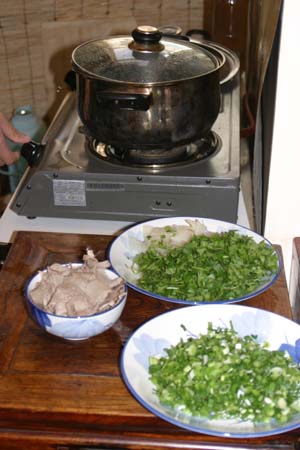 |
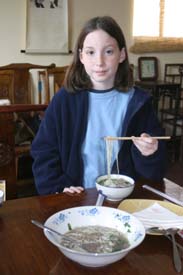 |
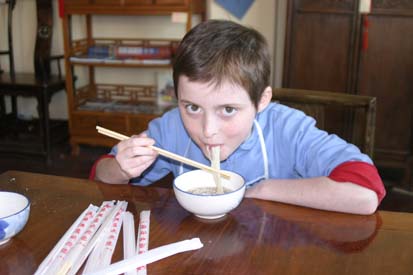 |
Delicious! Miranda pronounced that they tasted “just like Malan.” High praise indeed!
But what’s this? The chef was mixing up another batch of flour and water. Tom quickly jumped in to help, without knowing quite was the end product would be. It turned out to that the chef and his assistant were using the extra dough to make little three-cornered steamed pastries filled with a very dark brown sugar that melted into a super-hot, sticky, bubbly, delicious filling that tasted like molasses.
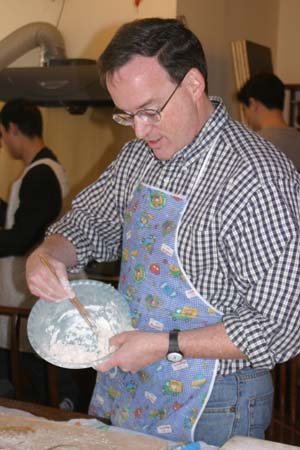 |
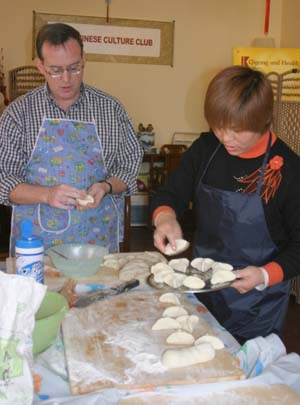 |
Another very typical northern snack.
Since our class, we have a new appreciation of la mian, and have been known to express disdain for dried noodles that aren’t pulled in front of our eyes. We have made the leap from fans to connoisseurs.
Miranda and I were in Malan a few days ago, in the middle of Spring Festival when non-Beijingers have left town for their home provinces and lots of stores are closed for the week. Malan, of course, stays open, day and night, even as all the other restaurants, hair salons, florist shops and pirate DVD joints on the block are shuttered for the new year holiday.
Malan is usually jammed at noon, but when we got there at 12:05, only one other customer was ahead of us. Turns out he was a security guard organizing a big take-out order for his buddies, and the distracted cook made our noodles while working on the big order. What with the dozen bowls of noodles for the guards, their vegetable side orders, and the security guard’s last minute demand for little containers of la jiao to take with him, we could tell the cook didn’t quite have his eye on our two small bowls of niu rou mian. After taking our food to the table and sampling the noodles, Miranda dryly commented, “I think the head chef must be out of town this week.”
So come and visit - after Spring Festival, the head chef will be back- and we’ll take you across the street for a bowl of la mian, made to order and hold the la jiao. Fifty cents never bought you a fresher, cheaper, tastier or more authentic Chinese meal!